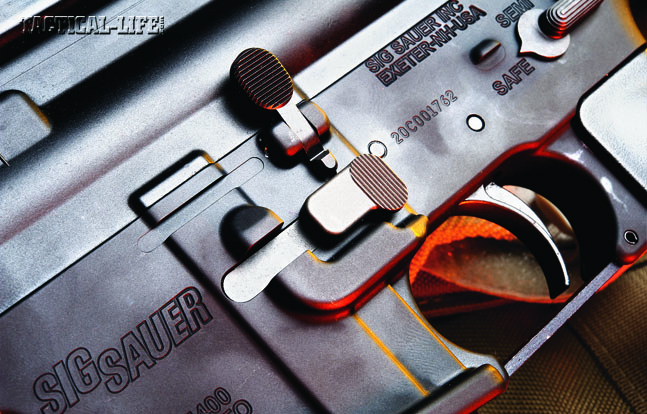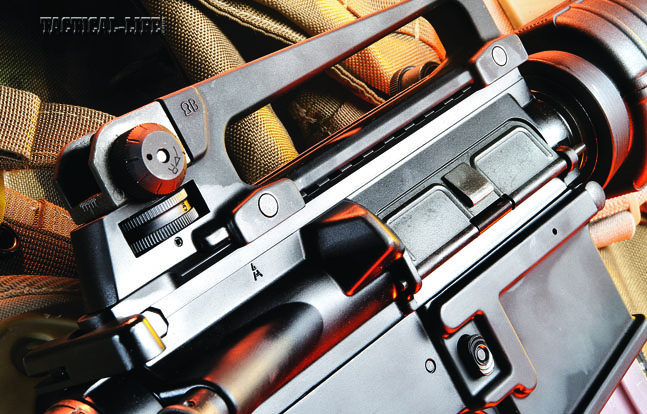Stepping back in time, the Sig name and reputation have their roots in a wagon factory above the Rhine Falls in Switzerland. It was there, in 1860, that Freidrich Peyer im Hof, Heinrich Moser and Conrad Neher created a state of-the-art rifle that would become the Swiss Army’s standard. They named the company the Schweizerische Industrie-Gesellschaft (Swiss Industrial Company) or “SIG” as it became known worldwide.
SIG evolved into the Swiss Army’s choice for pistols as well, first adopting the P49 forerunner of the P210, then the P220 and the P230. SIG’s small arms division was expanded to include J.P. Sauer & Sohn, GmbH, of Eckernförde, West Germany, and Hämmerli Target Arms from Lenzburg, Switzerland. Following great success in Europe, the company came to America, opening its U.S. division, Sig Arms, in 1985. The Virginia-based company moved to its present location of Exeter, New Hampshire, in 1990 to begin domestic production of the P229.
Today, the company officially is known as Sig Sauer, a corporate brand that continues to pay tribute to a worldwide legacy and reputation. Sig Sauer is an ISO 9001-certified company with more than 300 employees. Sig Sauer not only manufactures and distributes some of the world’s most reliable handguns, long guns and accessories, but they offer high-quality training through their world-renowned Sig Sauer Academy located in Epping, New Hampshire. U.S. Navy Seals, Federal Air Marshals, Department of Homeland Security, U.S. Coast Guard, state and numerous local law enforcement agencies rely on Sig Sauer firearms and training.
Advertisement — Continue Reading Below
A New Step for Sig
When Eugene Stoner’s patents, originally purchased by Colt from ArmaLite Fairchild, expired, dozens of firearms companies started building their own similar AR designs. At last count, I came up with about 75 companies building ARs. Several long-established gun companies were joined by newcomers as the industry grew.
Fast-forward a few years, and the presidential election, wars in Afghanistan and Iraq and the start of a heavy recession collectively hit the gun industry like a hammer. Ammunition and firearms prices skyrocketed and supply couldn’t meet demand. Adding to the furor were the various military weapons trials trying to unseat the half-century-old dominance of the AR-15/M16/M4 as the dominant U.S. military and law enforcement weapon.
Many gun companies wanted their share of the AR pie, and companies that I thought I would never see offer an AR model joined the fray. It made perfect sense for Sig to join the fun with their fine SIG516 series of gas piston ARs. There’s a common perception that piston-driven ARs are a step above the good old direct gas impingement ones, so that fit well with Sig’s modus operandi for building quality weapons. I’ve had similar conversations with representatives from well-established companies that wanted to play in the AR game but didn’t want to come to market with the same direct impingement AR that somebody could build in their basement.
Advertisement — Continue Reading Below
After Sig met the gun market’s demand for their new rifles, and the gun-buying craze subsided, it was time to take a hard look at what the market needed and would bear. It made perfect sense for them to appeal to law enforcement agencies with tight budgets and price-conscious consumers with a direct impingement gun at a lower price. Answering that call is Sig Sauer’s M400 series tactical rifle, designed for use in law enforcement, military operations, or the sporting field as well as competitive shooting.
Gun Details
The M400 is a true AR-platform tactical rifle that provides excellent accuracy, with a 16-inch chrome-lined, phosphate-coated barrel that provides maximum durability and corrosion resistance. A 7075-T6 aircraft-grade aluminum forged lower receiver adds to its durability and reliability.
The M400’s military-standard trigger breaks at 7.6 pounds. The barrel sports a six-groove, 1-in-7-inch twist rate that has an M4 contour measuring 16 inches. The A2 front sight includes a bayonet lug that fits Sig Sauer’s 40mm grenade launcher. A removable carrying handle incorporates adjustable rear sights. A six-position collapsible buttstock takes the overall length to a maximum of 39.5 inches. Some of my favorite components of the M400 are the flush-cup sling attachment points machined into the lower receiver.
Advertisement — Continue Reading Below
Sig Sauer Product Manager-Special Weapon Systems Dave Grimshaw talk-ed about the new M400 platform, launched in early April 2011. The M400 is Sig’s newest AR-platform rifle, similar to the SIG516, except for the gas impingement operation of the M400.
“It’s basically an AR-platform rifle. We call it the Sig M400,” Grimshaw said. “It has a lot of the same features that you might be aware of with our SIG516 platform, other than this is a gas impingement gun and not a gas piston rifle. Some of the features that are incorporated into this rifle are all the ambidextrous features that we see in the SIG516. We do have a supported extractor in this rifle as well. It is basically an M4 handguard, an M4-type stock with an A2 pistol grip. We have the removable sight assembly, 0- to 600-meter rear sight and adjustable front sight, as well.”
At the Range
The long-range portion of the testing for the Sig Sauer M400 was performed by shooting several five-shot groups at 100 yards from a Bulls Bag sitting on a steady bench. A minimum of three 5-shot groups were fired with each load. The optic chosen to wring the best performance out of the M400 was a Trijicon AccuPoint 5-20x scope in a set of JP Enterprises rings mounted to the weapon’s Picatinny rail. A Shooting Chrony Beta chronograph was used to gather velocity data for 10 shots with each load. After shooting for groups, I fired another ten 30-round magazines offhand with a 4X ACOG in place on various targets set from 25 feet to 50 yards. Every load functioned flawlessly.
Eight factory loads were tested, with the M400 showing a distinct preference for Hornady’s 55-grain TAP ammunition. The average velocity was clocked at 2,911 FPS (feet per second). The smallest group measured 0.652 inches, and the average for four groups measured 1.178 inches.
Advertisement — Continue Reading Below
The Sig Sauer M400 is an elite rendition of Stoner’s original design. Living up to Sig Sauer’s reputation, this market-conscious rifle will provide law enforcement agencies with a high-quality system at an affordable price.
Sig Sauer
sigsauer.com
603-772-2302
































